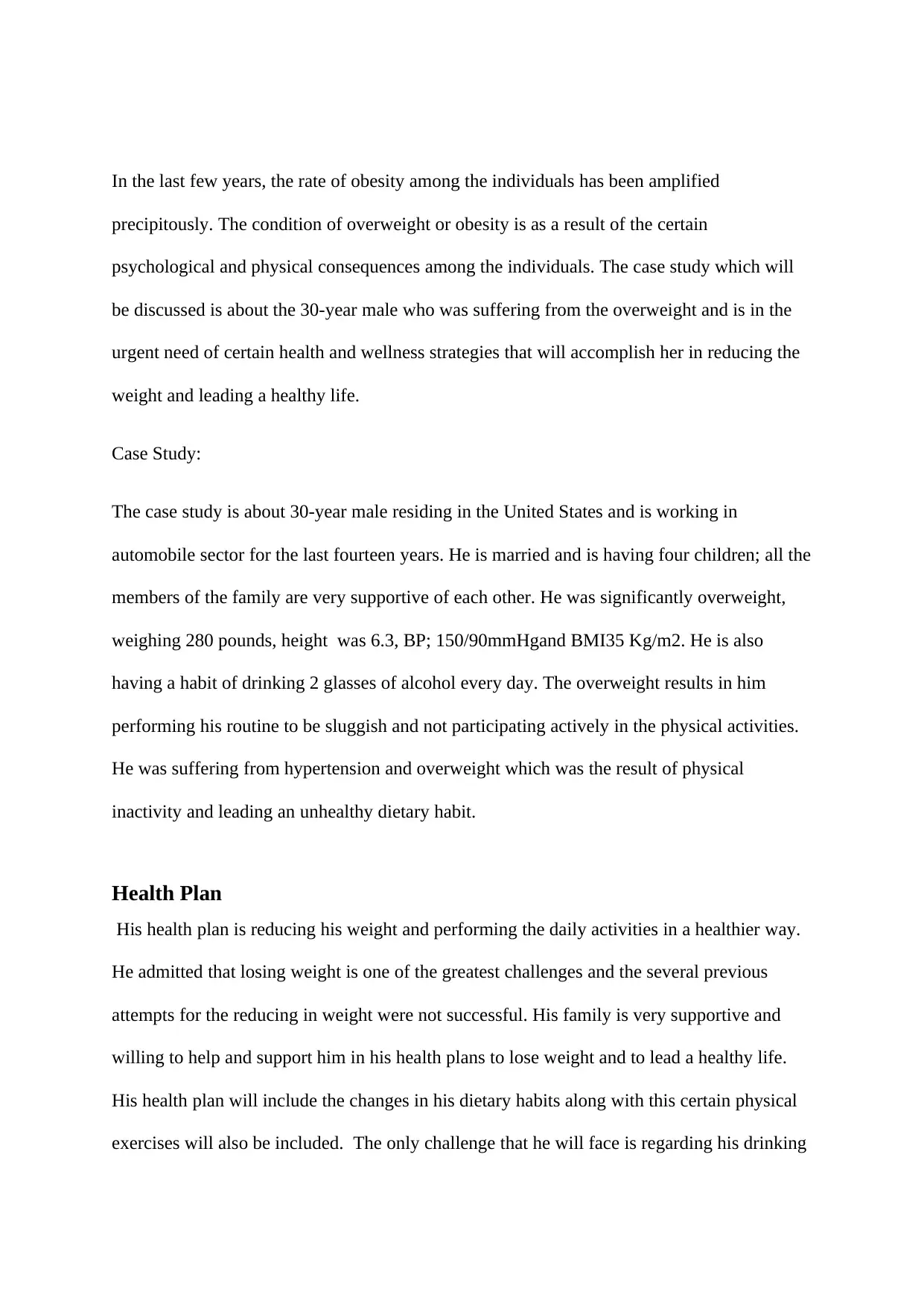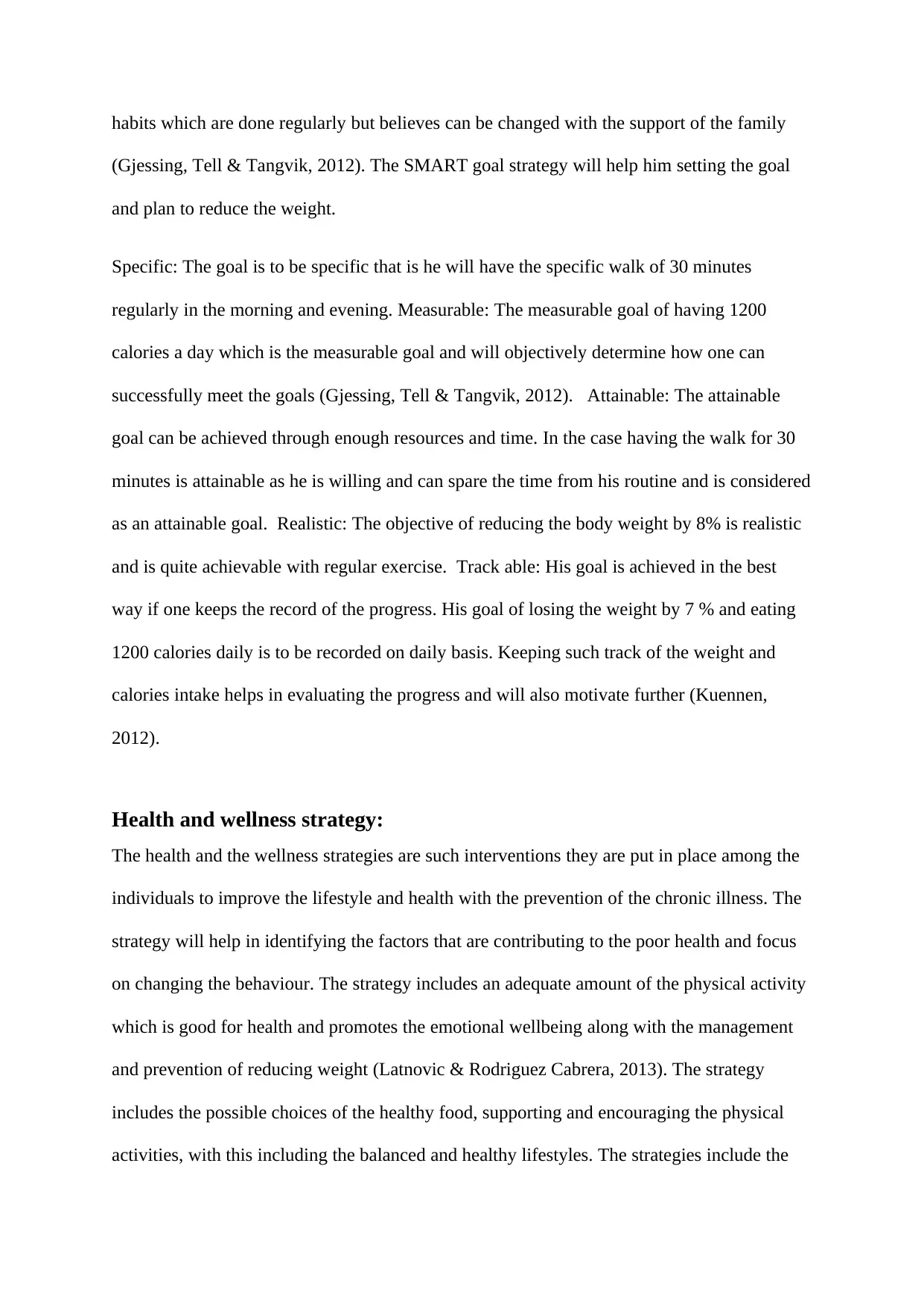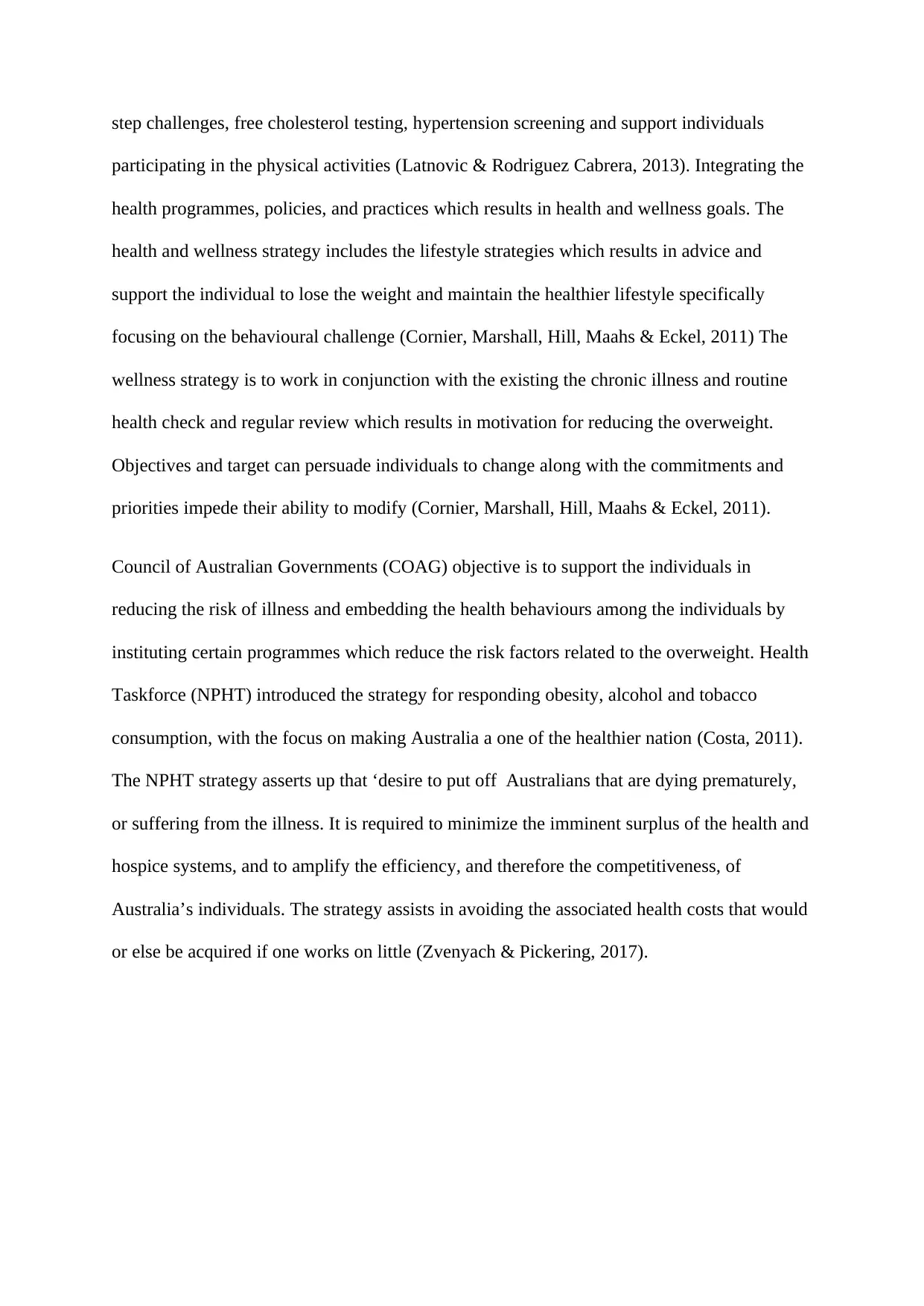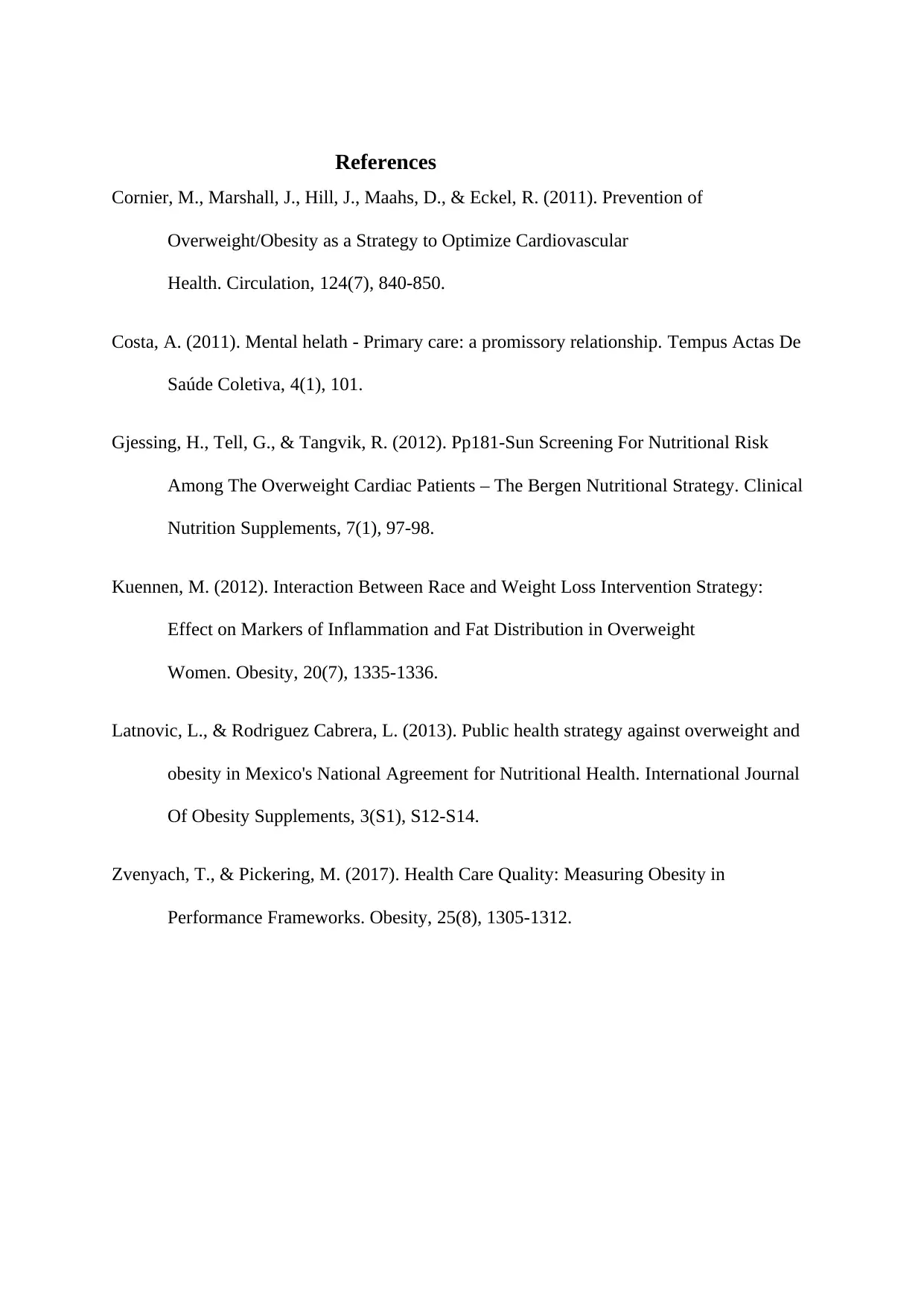Health and Wellness Strategies: A Case Study on Overweight Male in US
VerifiedAdded on 2023/06/14
|4
|1216
|87
Case Study
AI Summary
This case study examines a 30-year-old overweight male, weighing 280 pounds with a BMI of 35 Kg/m2 and suffering from hypertension, who seeks to improve his health and wellness. The case study details the subject's background, including his family support and challenges related to drinking habits. A SMART goal strategy is outlined, focusing on specific, measurable, attainable, realistic, and trackable objectives such as daily walks and calorie intake reduction. The health plan integrates lifestyle changes, physical activity, and healthy eating, referencing Australian government initiatives for promoting health and wellness. The strategy aims to address behavioral challenges, reduce the risk of chronic illness, and support sustainable lifestyle improvements, with an emphasis on regular health checks and motivation for weight loss.

In the last few years, the rate of obesity among the individuals has been amplified
precipitously. The condition of overweight or obesity is as a result of the certain
psychological and physical consequences among the individuals. The case study which will
be discussed is about the 30-year male who was suffering from the overweight and is in the
urgent need of certain health and wellness strategies that will accomplish her in reducing the
weight and leading a healthy life.
Case Study:
The case study is about 30-year male residing in the United States and is working in
automobile sector for the last fourteen years. He is married and is having four children; all the
members of the family are very supportive of each other. He was significantly overweight,
weighing 280 pounds, height was 6.3, BP; 150/90mmHgand BMI35 Kg/m2. He is also
having a habit of drinking 2 glasses of alcohol every day. The overweight results in him
performing his routine to be sluggish and not participating actively in the physical activities.
He was suffering from hypertension and overweight which was the result of physical
inactivity and leading an unhealthy dietary habit.
Health Plan
His health plan is reducing his weight and performing the daily activities in a healthier way.
He admitted that losing weight is one of the greatest challenges and the several previous
attempts for the reducing in weight were not successful. His family is very supportive and
willing to help and support him in his health plans to lose weight and to lead a healthy life.
His health plan will include the changes in his dietary habits along with this certain physical
exercises will also be included. The only challenge that he will face is regarding his drinking
precipitously. The condition of overweight or obesity is as a result of the certain
psychological and physical consequences among the individuals. The case study which will
be discussed is about the 30-year male who was suffering from the overweight and is in the
urgent need of certain health and wellness strategies that will accomplish her in reducing the
weight and leading a healthy life.
Case Study:
The case study is about 30-year male residing in the United States and is working in
automobile sector for the last fourteen years. He is married and is having four children; all the
members of the family are very supportive of each other. He was significantly overweight,
weighing 280 pounds, height was 6.3, BP; 150/90mmHgand BMI35 Kg/m2. He is also
having a habit of drinking 2 glasses of alcohol every day. The overweight results in him
performing his routine to be sluggish and not participating actively in the physical activities.
He was suffering from hypertension and overweight which was the result of physical
inactivity and leading an unhealthy dietary habit.
Health Plan
His health plan is reducing his weight and performing the daily activities in a healthier way.
He admitted that losing weight is one of the greatest challenges and the several previous
attempts for the reducing in weight were not successful. His family is very supportive and
willing to help and support him in his health plans to lose weight and to lead a healthy life.
His health plan will include the changes in his dietary habits along with this certain physical
exercises will also be included. The only challenge that he will face is regarding his drinking
Paraphrase This Document
Need a fresh take? Get an instant paraphrase of this document with our AI Paraphraser

habits which are done regularly but believes can be changed with the support of the family
(Gjessing, Tell & Tangvik, 2012). The SMART goal strategy will help him setting the goal
and plan to reduce the weight.
Specific: The goal is to be specific that is he will have the specific walk of 30 minutes
regularly in the morning and evening. Measurable: The measurable goal of having 1200
calories a day which is the measurable goal and will objectively determine how one can
successfully meet the goals (Gjessing, Tell & Tangvik, 2012). Attainable: The attainable
goal can be achieved through enough resources and time. In the case having the walk for 30
minutes is attainable as he is willing and can spare the time from his routine and is considered
as an attainable goal. Realistic: The objective of reducing the body weight by 8% is realistic
and is quite achievable with regular exercise. Track able: His goal is achieved in the best
way if one keeps the record of the progress. His goal of losing the weight by 7 % and eating
1200 calories daily is to be recorded on daily basis. Keeping such track of the weight and
calories intake helps in evaluating the progress and will also motivate further (Kuennen,
2012).
Health and wellness strategy:
The health and the wellness strategies are such interventions they are put in place among the
individuals to improve the lifestyle and health with the prevention of the chronic illness. The
strategy will help in identifying the factors that are contributing to the poor health and focus
on changing the behaviour. The strategy includes an adequate amount of the physical activity
which is good for health and promotes the emotional wellbeing along with the management
and prevention of reducing weight (Latnovic & Rodriguez Cabrera, 2013). The strategy
includes the possible choices of the healthy food, supporting and encouraging the physical
activities, with this including the balanced and healthy lifestyles. The strategies include the
(Gjessing, Tell & Tangvik, 2012). The SMART goal strategy will help him setting the goal
and plan to reduce the weight.
Specific: The goal is to be specific that is he will have the specific walk of 30 minutes
regularly in the morning and evening. Measurable: The measurable goal of having 1200
calories a day which is the measurable goal and will objectively determine how one can
successfully meet the goals (Gjessing, Tell & Tangvik, 2012). Attainable: The attainable
goal can be achieved through enough resources and time. In the case having the walk for 30
minutes is attainable as he is willing and can spare the time from his routine and is considered
as an attainable goal. Realistic: The objective of reducing the body weight by 8% is realistic
and is quite achievable with regular exercise. Track able: His goal is achieved in the best
way if one keeps the record of the progress. His goal of losing the weight by 7 % and eating
1200 calories daily is to be recorded on daily basis. Keeping such track of the weight and
calories intake helps in evaluating the progress and will also motivate further (Kuennen,
2012).
Health and wellness strategy:
The health and the wellness strategies are such interventions they are put in place among the
individuals to improve the lifestyle and health with the prevention of the chronic illness. The
strategy will help in identifying the factors that are contributing to the poor health and focus
on changing the behaviour. The strategy includes an adequate amount of the physical activity
which is good for health and promotes the emotional wellbeing along with the management
and prevention of reducing weight (Latnovic & Rodriguez Cabrera, 2013). The strategy
includes the possible choices of the healthy food, supporting and encouraging the physical
activities, with this including the balanced and healthy lifestyles. The strategies include the

step challenges, free cholesterol testing, hypertension screening and support individuals
participating in the physical activities (Latnovic & Rodriguez Cabrera, 2013). Integrating the
health programmes, policies, and practices which results in health and wellness goals. The
health and wellness strategy includes the lifestyle strategies which results in advice and
support the individual to lose the weight and maintain the healthier lifestyle specifically
focusing on the behavioural challenge (Cornier, Marshall, Hill, Maahs & Eckel, 2011) The
wellness strategy is to work in conjunction with the existing the chronic illness and routine
health check and regular review which results in motivation for reducing the overweight.
Objectives and target can persuade individuals to change along with the commitments and
priorities impede their ability to modify (Cornier, Marshall, Hill, Maahs & Eckel, 2011).
Council of Australian Governments (COAG) objective is to support the individuals in
reducing the risk of illness and embedding the health behaviours among the individuals by
instituting certain programmes which reduce the risk factors related to the overweight. Health
Taskforce (NPHT) introduced the strategy for responding obesity, alcohol and tobacco
consumption, with the focus on making Australia a one of the healthier nation (Costa, 2011).
The NPHT strategy asserts up that ‘desire to put off Australians that are dying prematurely,
or suffering from the illness. It is required to minimize the imminent surplus of the health and
hospice systems, and to amplify the efficiency, and therefore the competitiveness, of
Australia’s individuals. The strategy assists in avoiding the associated health costs that would
or else be acquired if one works on little (Zvenyach & Pickering, 2017).
participating in the physical activities (Latnovic & Rodriguez Cabrera, 2013). Integrating the
health programmes, policies, and practices which results in health and wellness goals. The
health and wellness strategy includes the lifestyle strategies which results in advice and
support the individual to lose the weight and maintain the healthier lifestyle specifically
focusing on the behavioural challenge (Cornier, Marshall, Hill, Maahs & Eckel, 2011) The
wellness strategy is to work in conjunction with the existing the chronic illness and routine
health check and regular review which results in motivation for reducing the overweight.
Objectives and target can persuade individuals to change along with the commitments and
priorities impede their ability to modify (Cornier, Marshall, Hill, Maahs & Eckel, 2011).
Council of Australian Governments (COAG) objective is to support the individuals in
reducing the risk of illness and embedding the health behaviours among the individuals by
instituting certain programmes which reduce the risk factors related to the overweight. Health
Taskforce (NPHT) introduced the strategy for responding obesity, alcohol and tobacco
consumption, with the focus on making Australia a one of the healthier nation (Costa, 2011).
The NPHT strategy asserts up that ‘desire to put off Australians that are dying prematurely,
or suffering from the illness. It is required to minimize the imminent surplus of the health and
hospice systems, and to amplify the efficiency, and therefore the competitiveness, of
Australia’s individuals. The strategy assists in avoiding the associated health costs that would
or else be acquired if one works on little (Zvenyach & Pickering, 2017).
⊘ This is a preview!⊘
Do you want full access?
Subscribe today to unlock all pages.

Trusted by 1+ million students worldwide

References
Cornier, M., Marshall, J., Hill, J., Maahs, D., & Eckel, R. (2011). Prevention of
Overweight/Obesity as a Strategy to Optimize Cardiovascular
Health. Circulation, 124(7), 840-850.
Costa, A. (2011). Mental helath - Primary care: a promissory relationship. Tempus Actas De
Saúde Coletiva, 4(1), 101.
Gjessing, H., Tell, G., & Tangvik, R. (2012). Pp181-Sun Screening For Nutritional Risk
Among The Overweight Cardiac Patients – The Bergen Nutritional Strategy. Clinical
Nutrition Supplements, 7(1), 97-98.
Kuennen, M. (2012). Interaction Between Race and Weight Loss Intervention Strategy:
Effect on Markers of Inflammation and Fat Distribution in Overweight
Women. Obesity, 20(7), 1335-1336.
Latnovic, L., & Rodriguez Cabrera, L. (2013). Public health strategy against overweight and
obesity in Mexico's National Agreement for Nutritional Health. International Journal
Of Obesity Supplements, 3(S1), S12-S14.
Zvenyach, T., & Pickering, M. (2017). Health Care Quality: Measuring Obesity in
Performance Frameworks. Obesity, 25(8), 1305-1312.
Cornier, M., Marshall, J., Hill, J., Maahs, D., & Eckel, R. (2011). Prevention of
Overweight/Obesity as a Strategy to Optimize Cardiovascular
Health. Circulation, 124(7), 840-850.
Costa, A. (2011). Mental helath - Primary care: a promissory relationship. Tempus Actas De
Saúde Coletiva, 4(1), 101.
Gjessing, H., Tell, G., & Tangvik, R. (2012). Pp181-Sun Screening For Nutritional Risk
Among The Overweight Cardiac Patients – The Bergen Nutritional Strategy. Clinical
Nutrition Supplements, 7(1), 97-98.
Kuennen, M. (2012). Interaction Between Race and Weight Loss Intervention Strategy:
Effect on Markers of Inflammation and Fat Distribution in Overweight
Women. Obesity, 20(7), 1335-1336.
Latnovic, L., & Rodriguez Cabrera, L. (2013). Public health strategy against overweight and
obesity in Mexico's National Agreement for Nutritional Health. International Journal
Of Obesity Supplements, 3(S1), S12-S14.
Zvenyach, T., & Pickering, M. (2017). Health Care Quality: Measuring Obesity in
Performance Frameworks. Obesity, 25(8), 1305-1312.
1 out of 4
Related Documents
Your All-in-One AI-Powered Toolkit for Academic Success.
+13062052269
info@desklib.com
Available 24*7 on WhatsApp / Email
![[object Object]](/_next/static/media/star-bottom.7253800d.svg)
Unlock your academic potential
Copyright © 2020–2025 A2Z Services. All Rights Reserved. Developed and managed by ZUCOL.




